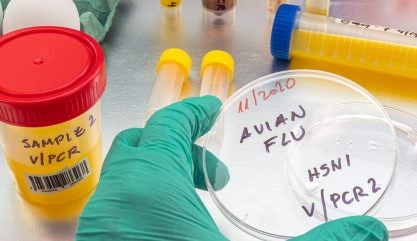
Major disruption to global poultry and egg markets has been brought into sharper focus by US Agriculture Secretary Tom Vilsack’s comments last week that the department is a year and a half away from finding a vaccine for avian flu.
The current strain of so-called ‘bird flu’, or avian influenza, has killed 82 million poultry and aquatic birds across 47 US states since January 2022.

US Tariffs are shifting - will you react or anticipate?
Don’t let policy changes catch you off guard. Stay proactive with real-time data and expert analysis.
By GlobalDataAside from drastically raising the prices of poultry and eggs for consumers and businesses, avian flu also poses a threat to humans.
In late January and early February, the first human cases of 2024 were identified in Cambodia, according to the Centers for Disease Control and Prevention. One was an adult and three were children, one of whom died.
“We are probably 18 months or so away from being able to identify a vaccine that would be effective for this particular [avian flu] that we’re dealing with now,” Vilsack said at a congressional hearing in Washington D.C.
“The USDA’s Agricultural Research Service (ARS) began testing candidate vaccines in 2023”, USDA press secretary Allan Rodriguez tells Just Food. “The decision to proceed with vaccination is complex – from vaccine development to production timelines, to dissemination to flocks, there are many factors that make implementing a vaccine strategy a challenge and it would take time to deliver an effective vaccine.”
A poultry pandemic?
While Vilsack’s approximate timeline shows progress in the US Department of Agriculture’s (USDA) efforts to contain avian flu, the 18-month delay in the vaccine’s rollout will wreak further havoc on US food supply chains, says Ramsey Baghdadi, consumer analyst at GlobalData, Just Food‘s parent company.
“The inability to supply a vaccine immediately will cause challenges for US farmers, and chicken culls throughout the country will be forced to continue,” Baghdadi tells Just Food.
Both Baghdadi’s comments and Vilsack’s statements align with the World Organization for Animal Health’s (WOAH) advice that governments should consider bird flu vaccinations for poultry to prevent the spread of the virus from becoming a pandemic.
“Vaccinating is not the end, it is just the beginning,” disease expert David Swayne said at a WOAH forum addressing avian flu in June. “Vaccination application needs to be managed along the supply chain including a surveillance programme which is able to detect active infection in vaccinated animals.”
US egg prices peaked at a nationwide average of $4.82 per dozen in January 2023 – more than double the $1.93 per dozen charged a year earlier before the US’ first avian flu case. The prices remained around $2.07 per dozen at the end of 2023.
Baghdadi also emphasises that the ethical requirements to vaccinate bird populations against avian flu correlate with – and trump – economic considerations.
“Providing the appropriate medications for animal care is a vital aspect of an ethical supply chain,” Baghdadi says. “The most significant challenge in the wait for a bird flu vaccine is the threat of losing organic and free-range certifications from USDA, as chickens and pigs are forced into lockdown.”
California’s animal welfare requirements mean “chaos” for meat markets
Government and consumer-driven demand for more stringent animal welfare has resulted in several US states adopting tighter regulation in meat and poultry supply chains.
In the same congressional hearing, Vilsack said that California’s Prop 12 law, which has tightened animal requirements for pork products sold in the state, is causing “chaos in the marketplace”.
Vilsack also highlighted differences between state and federal regulation as a disruptive factor.
“When each state has the ability to define for itself and its consumers exactly what farming techniques or practices are appropriate, it does create the possibility of 50 different sets of rules and regulations,” he said.
While state-by-state differences pose a logistical nightmare for nationwide distributors, the demand for ethically sourced poultry is evident.
55% of US consumers find organic products an essential or nice to have feature in their product decision-making, according to a survey by GlobalData in Q4 2023.
“Loss of the [organic] claim could lead consumers to temporarily choose imported chicken products over local ones,” says Baghdadi. “In the long term, local US farmers should use traceable technology such as blockchain, which gives the end-consumer more information about the supply chain journey and where the product is sourced. Traceability will ultimately help consumers trust in times of bird flu, as consumers will be able to trace the products are not from a contaminated farm.”




